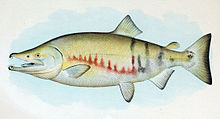| Chum salmon | |
|---|---|

| |
| Scientific classification | |
| Domain: | Eukaryota |
| Kingdom: | Animalia |
| Phylum: | Chordata |
| Class: | Actinopterygii |
| Order: | Salmoniformes |
| Family: | Salmonidae |
| Genus: | Oncorhynchus |
| Species: | O. keta
|
| Binomial name | |
| Oncorhynchus keta (Walbaum, 1792)
| |
The chum salmon (Oncorhynchus keta), also known as dog salmon or keta salmon,[1] is a species of anadromous salmonid fish from the genus Oncorhynchus (Pacific salmon) native to the coastal rivers of the North Pacific and the Beringian Arctic, and is often marketed under the trade name silverbrite salmon in North America. The English name "chum salmon" comes from the Chinook Jargon term tsəm, meaning "spotted" or "marked"; while keta in the scientific name comes from Russian, which in turn comes from the Evenki language of Eastern Siberia.[2] The term 'Dog Salmon' is most commonly used in Alaska and refers to the Salmon whose flesh Alaskans use to feed their dogs.[citation needed]
In Japan, chum salmon is also known as the white salmon (白鮭 シロサケ, shiro sake), autumn salmon (秋鮭 アキサケ, aki sake) or simply "the salmon" (鮭 サケ, sa ke), while historically it was known in kun'yomi as "stone katsura fish" (石桂魚 さけ, sa ke) up until the Meiji period.[3] In Greater China, it is known academically as the "hook-snout salmon" (Chinese: 钩吻鲑), but is more often called the damaha fish (simplified Chinese: 大马哈鱼; traditional Chinese: 大麻哈魚), which is borrowed from dawa ịmaχa, the Nanai name of the fish used by the Hezhe minority in northern Northeast China.
- ^ LaDonna Rose Gundersen (2012-07-18). "Shelf Life of Canned Salmon". LaDonna Rose. Retrieved 2024-06-28.
- ^ [email protected]. "Chum Salmon Species Profile, Alaska Department of Fish and Game". www.adfg.alaska.gov. Retrieved 2021-10-01.
- ^ フジテレビトリビア普及委員会 (2003). トリビアの泉〜へぇの本〜 1. 講談社.